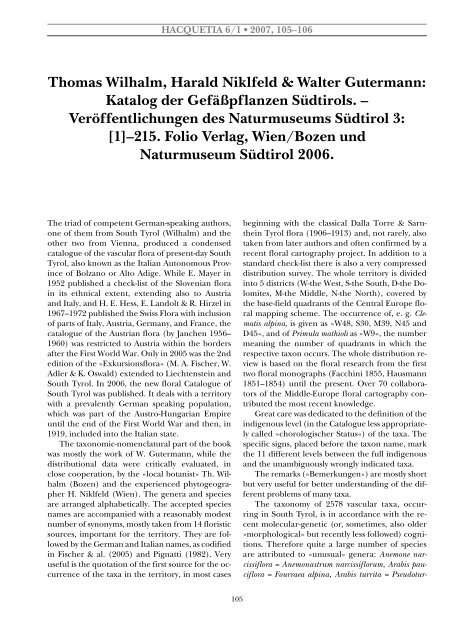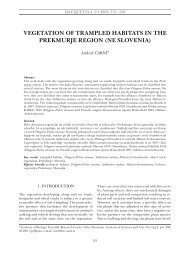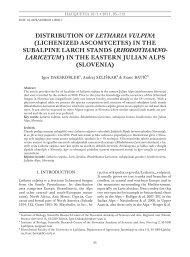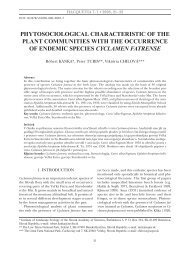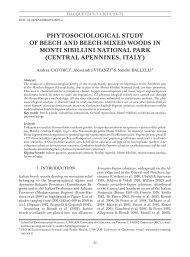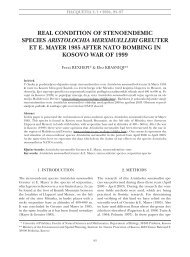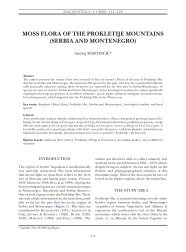Katalog der Gefäßpflanzen Südtirols. - Hacquetia
Katalog der Gefäßpflanzen Südtirols. - Hacquetia
Katalog der Gefäßpflanzen Südtirols. - Hacquetia
Create successful ePaper yourself
Turn your PDF publications into a flip-book with our unique Google optimized e-Paper software.
HACQUETIA 6/1 • 2007, 105–106<br />
Thomas Wilhalm, Harald Niklfeld & Walter Gutermann:<br />
<strong>Katalog</strong> <strong>der</strong> <strong>Gefäßpflanzen</strong> <strong>Südtirols</strong>. –<br />
Veröffentlichungen des Naturmuseums Südtirol 3:<br />
[1]–215. Folio Verlag, Wien/Bozen und<br />
Naturmuseum Südtirol 2006.<br />
The triad of competent German-speaking authors,<br />
one of them from South Tyrol (Wilhalm) and the<br />
other two from Vienna, produced a condensed<br />
catalogue of the vascular flora of present-day South<br />
Tyrol, also known as the Italian Autonomous Province<br />
of Bolzano or Alto Adige. While E. Mayer in<br />
1952 published a check-list of the Slovenian flora<br />
in its ethnical extent, extending also to Austria<br />
and Italy, and H. E. Hess, E. Landolt & R. Hirzel in<br />
1967–1972 published the Swiss Flora with inclusion<br />
of parts of Italy, Austria, Germany, and France, the<br />
catalogue of the Austrian flora (by Janchen 1956–<br />
1960) was restricted to Austria within the bor<strong>der</strong>s<br />
after the First World War. Only in 2005 was the 2nd<br />
edition of the »Exkursionsflora« (M. A. Fischer, W.<br />
Adler & K. Oswald) extended to Liechtenstein and<br />
South Tyrol. In 2006, the new floral Catalogue of<br />
South Tyrol was published. It deals with a territory<br />
with a prevalently German speaking population,<br />
which was part of the Austro-Hungarian Empire<br />
until the end of the First World War and then, in<br />
1919, included into the Italian state.<br />
The taxonomic-nomenclatural part of the book<br />
was mostly the work of W. Gutermann, while the<br />
distributional data were critically evaluated, in<br />
close cooperation, by the »local botanist« Th. Wilhalm<br />
(Bozen) and the experienced phytogeographer<br />
H. Niklfeld (Wien). The genera and species<br />
are arranged alphabetically. The accepted species<br />
names are accompanied with a reasonably modest<br />
number of synonyms, mostly taken from 14 floristic<br />
sources, important for the territory. They are followed<br />
by the German and Italian names, as codified<br />
in Fischer & al. (2005) and Pignatti (1982). Very<br />
useful is the quotation of the first source for the occurrence<br />
of the taxa in the territory, in most cases<br />
105<br />
beginning with the classical Dalla Torre & Sarnthein<br />
Tyrol flora (1906–1913) and, not rarely, also<br />
taken from later authors and often confirmed by a<br />
recent floral cartography project. In addition to a<br />
standard check-list there is also a very compressed<br />
distribution survey. The whole territory is divided<br />
into 5 districts (W-the West, S-the South, D-the Dolomites,<br />
M-the Middle, N-the North), covered by<br />
the base-field quadrants of the Central Europe floral<br />
mapping scheme. The occurrence of, e. g. Clematis<br />
alpina, is given as »W48, S30, M39, N45 and<br />
D45«, and of Primula mathioli as »W9«, the number<br />
meaning the number of quadrants in which the<br />
respective taxon occurs. The whole distribution review<br />
is based on the floral research from the first<br />
two floral monographs (Facchini 1855, Hausmann<br />
1851–1854) until the present. Over 70 collaborators<br />
of the Middle-Europe floral cartography contributed<br />
the most recent knowledge.<br />
Great care was dedicated to the definition of the<br />
indigenous level (in the Catalogue less appropriately<br />
called »chorologischer Status«) of the taxa. The<br />
specific signs, placed before the taxon name, mark<br />
the 11 different levels between the full indigenous<br />
and the unambiguously wrongly indicated taxa.<br />
The remarks (»Bemerkungen«) are mostly short<br />
but very useful for better un<strong>der</strong>standing of the different<br />
problems of many taxa.<br />
The taxonomy of 2578 vascular taxa, occurring<br />
in South Tyrol, is in accordance with the recent<br />
mo lecular-genetic (or, sometimes, also ol<strong>der</strong><br />
»morphological« but recently less followed) cognitions.<br />
Therefore quite a large number of species<br />
are attributed to »unusual« genera: Anemone narcissiflora<br />
= Anemonastrum narcissiflorum, Arabis pauciflora<br />
= Fourraea alpina, Arabis turrita = Pseudotur-
itis turrita, Avena pubescens = Homalotrichon pubescens,<br />
Cardaminopsis = Arabidopsis, Cortusa matthioli =<br />
Primula matthioli (why not, when compared with P.<br />
obconica!), Chenopodium botrys = Dysphania botrys, Leontodon<br />
autumnalis, L. helveticus, L. montanus = Scorzoneroides<br />
autumnalis, S. helvetica, S. montana, Ligusticum<br />
mutellina = Mutellina adonidifolia, L. seguieri =<br />
Coristospermum lucidum subsp. seguieri, Loiseleuria<br />
procumbens = Kalmia procumbens, Orchis coriophora,<br />
O. morio = Anacamptis coriophora, A. morio, O. ustulata,<br />
O. tridentata = Neotinea ustulata, N. tridentata,<br />
Peucedanum cervaria = Cervaria rivini, Potentilla rupestris<br />
= Drymocallis rupestris, Scabiosa graminifolia =<br />
Lomelosia graminifolia, Silene rupestris = Atocion rupestre,<br />
Thlaspi perfoliatum = Microthlaspi perfoliatum,<br />
Tamus communis = Dioscorea communis and similarly<br />
many others. The genera Comastoma and Gentianopsis<br />
are well acceptable to those with the Himalayan<br />
floristic experience. Some other genera like<br />
Bellidiastrum, Galatella, Helminthotheca or Noccaea<br />
were already known to the taxonomists temporis<br />
acti but are now reestablished. In »recompense«<br />
some genera, like Aegilops (Triticum), Anisantha<br />
(Bromus), Bromopsis (Bromus), Ceterach (Asplenium),<br />
Chamaespartium (Genista), Cicerbita (Lactuca), Conyza<br />
(Erigeron), Elyna (Kobresia), Lembotropis (Cytisus),<br />
Omalotheca (Gnaphalium), Phyllitis (Asplenium), Mycelis<br />
(Lactuca), and Tetragonolobus (Lotus) are merged<br />
into the genera sensu lato, as in the »good olden<br />
times«. (In brackets the »returned« genera.)<br />
While the delimitation and nomenclature of<br />
genera is reminiscent of a »taxonomical tsunami«,<br />
the changes in naming the species are insignificant.<br />
Allium senescens (A. montanum) is now A. lusitanicum,<br />
maybe just to remind the Eastern Europeans<br />
of a EU state at the farthest West. However, a little<br />
bit perplexing is that the Flora Europaea indicates<br />
»?Lu«.<br />
It is worth mentioning that the detailed treatment<br />
of the genus Hieracium is a fruit of the good<br />
knowledge of W. Gutermann and the important<br />
and valuable contributions of the German hieraciologist<br />
G. Gottschlich (Tübingen). Also very useful<br />
are the data provided by F. Prosser (Rovereto) for<br />
the Trento Province.<br />
As the only criticism to the Catalogue, I wish<br />
to mention the »blind/gray« map representing<br />
the division of South Tyrol into districts and quadrants<br />
(fig. 1) with no concrete geographical names<br />
(mountains, rivers, localities) and therefore of<br />
little value for foreigners. A full colour page with<br />
geographic names would essentialy facilitate the<br />
applicability of the Catalogue.<br />
Let us conclude to the best of our conviction<br />
that the Catalogue brings the most and the best of<br />
the critically estimated knowledge in an astonishingly<br />
concise form. It is a good example for other<br />
catalogues of territories with a similarly long floristic<br />
tradition.<br />
Tone Wraber


